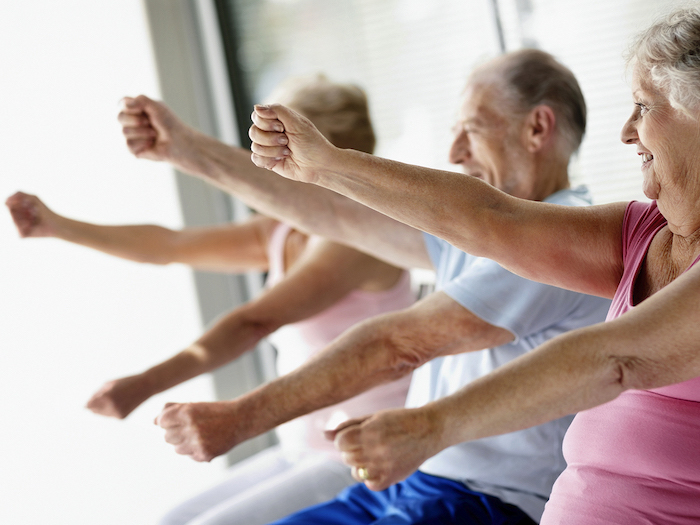6 Rules for Exercising with Parkinson’s Disease
The right workout routine can slow the disease's progression and improve quality of life. Here's how.

Parkinson's disease often feels like someone else is controlling your body. But the right exercise strategies can help you take back the reins.
“Clinically, I observe that the Parkinson’s patients who exercise most tend to do the best,” says Samuel A. Frank, M.D., a fellow of the American Academy of Neurology and an expert with the Parkinson’s Disease and Movement Disorders Center at Beth Israel Deaconess Medical Center in Boston.
Exercise can help improve everything from balance and coordination to mood and cognition, he says. And it may even slow the progression of the disease.
Parkinson’s is a neurodegenerative disorder that affects an area of the brain (the substantia nigra) that controls balance and movement. While experts don’t fully understand how exercise works to combat the disease, Dr. Frank notes that it may affect inflammatory pathways in the body that are linked to Parkinson’s.
Exercise may also promote neural plasticity, which is the brain’s ability to adapt and form new neural connections, adds Lisa M. Rusch, D.P.T., a geriatric physical therapist at Northern Westchester Hospital in Mount Kisco, New York.
And most important, it's never too late to start. "Whether diagnosed just recently or years ago, starting an exercise program at any point can be effective in managing the direct and indirect effects of Parkinson's disease," Rusch says.
"Before development of physical manifestations, the goal is to help prevent or delay the onset of motor changes," she explains. "If we can foresee the future, so to speak, we can set ourselves up for the best scenario possible."
That's where exercise comes in. But how can you get the greatest benefit while also staying safe? Follow these expert guidelines.
1. Talk to Your Specialists
The first step in your exercise routine should be to work with your doctor, says Ariane Park, M.D., M.P.H., an expert in Parkinson’s disease and other movement disorders at Ohio State University Wexner Medical Center Neurological Institute.
Before beginning any exercise program, make sure to receive medical clearance and discuss what forms of exercise are safe for you with your neurologist or primary care physician. Your doctor may refer you to a physical therapist who can help you learn exercises that are customized to fit your body, needs, and preferences.
2. Take Part in Planning Your Workouts
“The best type of exercise is the one chosen by the individual,” says Rusch, who encourages people to pick workouts that they enjoy and will perform consistently. Everything from tai chi to dance to ping-pong can be a great workout, she says.
"The type of exercise is less important than doing it and pushing yourself just slightly," Dr. Frank adds. Plus, a lot of people with Parkinson's can feel like they're losing control. Calling the shots with your fitness routine can help change that, he says.
3. Find a Gym Buddy
“Because the effects of Parkinson’s disease aren’t just physical and may include cardiorespiratory changes and even cognitive changes, supervision is most often recommended and always appropriate when just starting out,” Rusch says.

Try exercising with a friend, taking a group class, or signing up for one-on-one sessions with a trainer. Tell your instructor or trainer about any conditions you're managing, including Parkinson's disease, and any safety instructions from your doctor.
4. Build a Base of Strength
“Evidence suggests that strength training for individuals with Parkinson’s disease can improve gait parameters, safety with general mobility, and even reduce the risk of falling,” Rusch says.
She recommends focusing on strengthening the legs through functional exercises that mimic the movements used to walk (lunges), stand up from a chair (squats), and perform other everyday tasks.
It’s best to choose exercises that keep your feet in contact with the floor, including squats, stationary lunges, and toe raises, she says. And don’t hesitate to hold onto a stable object, like a chair or wall, for balance. When in doubt, always play it safe.
5. Prioritize Your Posture
"Because people with Parkinson's disease often have a rigid, stooped posture, flexibility exercises can be used to combat hunching and make movement easier," Rusch says. "The goal should be to work on reversing or, at the very least, stopping the forward pull of Parkinson's disease on the torso."
Performing both trunk rotation and trunk extension exercises can help.
"Trunk rotation is an integral part of gait and makes a world of difference in performing activities of daily living," she says, noting that trunk rotations can be performed lying down, sitting, or standing. In whichever position you choose, simply reach across your body while following your hands with your eyes. Try to keep your lower body still, and rotate from your middle.
Subscribe to our newsletter
It's quick and easy. You could be one of the 13 million people who are eligible.
Already a member? Click to discover our 15,000+ participating locations.
Follow Us
As for trunk extension, here's a handy exercise from Rusch: Stand with your back against a wall, bringing your head as close to the wall as possible. Extend your arms to make a big V framing your head. If possible, the backs of your hands should touch the wall behind you. From this position, try to make a "snow angel" against the wall, she says.
6. Train Your Gait
"Often, individuals with Parkinson's disease will experience short or shuffled steps and slowed walking speed, which increases the risk for tripping or falling and makes it more difficult to navigate certain areas," Rusch says. Walking in general can be helpful, but here are a few important things to remember.
Take big steps. “A goal generally is to have the heel of one foot pass the toes of the other on every step,” Rusch says.
Swing your arms. In people with Parkinson’s disease, arm swing can become smaller and smaller. However, by focusing on swinging your arm as your opposite leg steps forward, your trunk will naturally rotate so that you better maintain balance, Rusch says. Imagine exaggerated marching.
Hit with your heel. “Shuffled steps can often mean barely getting the foot off the floor as you move it forward,” Rusch says. “Emphasizing step length will often already improve clearance, but another way to help is to make sure your heel hits the ground first. This will force you to raise up your toes, reduce the shuffling, and improve your chances of clearing an obstacle like a floor mat or crack in the sidewalk.”
Look ahead. When you’re unsure of yourself, it can be tempting to look straight down toward the floor when walking. But that can actually throw off your balance and increase the risk of falls. “Keep your head and eyes forward, scanning your environment and making sure there aren’t any possible obstacles that could pose a tripping hazard,” Rusch says.
Start with short distances. “When it comes to walking, quality is far more important than quantity,” Rusch says. “So try not to worry about the distance. Focus on the gait pattern instead.”
Check Your SilverSneakers Eligibility Instantly
SilverSneakers members can go to thousands of gyms and fitness locations across the nation, plus take exercise classes designed for seniors and led by supportive instructors. If you have a Medicare Plan, it may include SilverSneakers—at no additional cost. Check your eligibility instantly here.
Already a member? Get your SilverSneakers member ID and exclusive fitness content by logging in to or creating your online account here.





